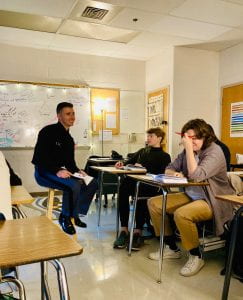
During our last visit at the high school, Keenan and I were a bit nervous as we were not actually prepared for the assignment the students were learning for that day. You see, Keenan and I were awake until roughly around 4:00 am the night before working on our Capstones, so we were struggling. However, we still managed to pull it off with the help of the students.
We were assigned with Act. 4 scene 1 of King Lear, and Mrs. Knepper wanted us to help the students understand the importance of this scene and it’s significant details. On the way to the high school, Keenan and I listened to a 7 minute video that summarized the scene so that we had somewhat of a clue as to what was going on, but luckily, thanks to Mrs. Knepper’s kindness and understanding, she had the students read the scene together as a class before we got started. This allowed me and Keenan enough time to get a decent idea of the importance of this scene. Then we split up into groups, with Keenan and I dividing up the class. For my group specifically, we went over each stanza in the play, pointing out important details and the key significance that the author wants us to take away. After going through the entire scene, I then helped the students fill out the worksheet that Mrs. Knepper handed out to the class before the lesson.
While engaging with the students, a surprise that struck me was that the students worked more efficiently by allowing them to brainstorm and speak their ideas freely to each other. Usually, I would have figured that this would have caused the students to get distracted and run off topic, but by just letting them speak and roll with it, they were able to come up with some impressive ideas about the scene. I would just sit their patiently waiting for them to finish speaking their thoughts, as they kept adding thoughtful insight to their gatherings. This gave me some good notes to write down regarding how to approach the classroom. It is not always a good thing to be straight forward and direct, rather it is productive to let the students think for themselves and then tie everyone’s thoughts together at the end and relate it to the significance of the assignment.
